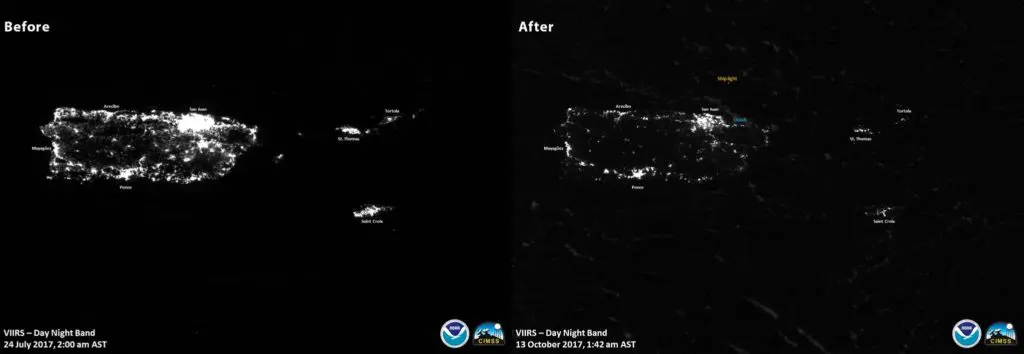An EnergyVision for Puerto Rico
When Hurricane Maria hit Puerto Rico on September 20, it plunged the island into a devastating power outage. This NOAA satellite photo shows visible lights in Puerto Rico and the U.S. Virgin Islands before the storm (July 24) and after (October 13). It took two months to restore more than half of normal peak load electricity, as of early-December, almost a third of households are still in the dark.
In May, Acadia Center released EnergyVision 2030: Transitioning to a Low-Emissions Energy System, a comprehensive analysis that demonstrates how seven Northeast states can spur use of market-ready technologies that empower consumers, control energy costs, and advance economic growth while lowering carbon pollution. EnergyVision 2030 presents a practical path to a clean energy future where electricity produced by solar, wind, and other renewable technologies powers our cars and provides efficient heating; where residents and businesses anchor an integrated grid, with power flowing between consumers and among smart appliances and batteries, within energy efficient buildings; and where community energy provides equitable access to renters, low-income ratepayers, and those who cannot site clean energy at their own homes. EnergyVision 2030 is ambitious, optimistic, and achievable.
In September, Hurricanes Irma and Maria devastated Puerto Rico, leaving 3.4 million people without power, clean water, food, or cell phone service. Almost three months later, a third of the island is still in the dark. While officials warn that it will take many more months and many billions of dollars to repair the island’s electricity transmission and distribution system and restore some sort of normalcy, creative thinkers are asking what might be possible if—instead of fast-tracking huge investments in rebuilding Puerto Rico’s troubled, traditional grid— Puerto Rico builds an affordable clean energy system of the future.
This clean energy future would be a significant departure from Puerto Rico’s pre-hurricane energy system, which depended heavily on fossil fuels and resulted in the highest retail electricity prices for American citizens outside of Hawaii. Despite including both the Caribbean’s largest solar farm and its largest wind farm, renewable energy supplied only 2.4% of Puerto Rico’s electricity in 2016. That’s far short of the 2010 Renewable Portfolio Standard (“RPS”) requiring the Puerto Rico Electric Power Authority (“PREPA”) to get 12% of its electricity from renewable sources starting in 2015, scaling up to 15% by 2020 and 20% by 2035. Missing the RPS target is not PREPA’s only problem. The agency’s debt tops $9 billion, its infrastructure is old and failing, and service is often unreliable. The bottom line is that Puerto Rico was ripe for grid modernization even before Hurricane Maria wiped out the grid.
Weaving strategic grid modernization into emergency response will require sensitivity, and Acadia Center’s EnergyVision lays the foundation for ambitious, achievable reforms anchored by clean energy technologies in four core areas:
Grid Modernization: Advocates on Puerto Rico and the mainland are abuzz with the potential of a modern system of microgrids. These localized grids incorporate renewable generation and battery storage to avoid the need for expensive long-distance transmission and distribution lines, and are more resilient than traditional, centralized grids. The impact of Hurricane Maria bears this out: though the storm took out 80% of transmission lines, it damaged only 10-15% of solar panels. Functioning panels weren’t able to deliver power to the now-destroyed grid, but interconnecting those panels through local microgrids would be particularly useful, especially given Puerto Rico’s terrain of forests and mountains through which it is difficult to maintain power lines. Renewable energy companies have stepped up since the hurricanes: German energy storage manufacturer Sonnen already has six microgrids up and running, with nine more installations planned in coming weeks; Tesla deployed solar and storage to restore power at San Juan’s Children’s Hospital and has announced six new battery projects on two Puerto Rican islands. Taxpayer-funded disaster relief should encourage innovations like these to lend immediate support to traumatized Puerto Ricans and to demonstrate the potential of a smart, clean, modern grid.
Electric Generation: Puerto Rico has ample renewable resources, yet last year, petroleum supplied nearly half of the island’s electricity, and natural gas supplied nearly one-third. Solar power is the fastest source of clean, renewable generation. As of June 2017, Puerto Rico had five utility-scale solar farms with 127 megawatts of capacity, and more than 8,500 customers with nearly 88 megawatts of distributed capacity connected with net metering. Expanding grid-scale and distributed renewable generation to achieve and surpass RPS targets will mitigate high fuel costs, advance energy independence, reduce emissions, and support a more resilient energy system.
Buildings: Energy efficiency and clean building-cooling and water-heating technologies have already provided cost savings and emissions reductions in Puerto Rico. The island utilized funds from the American Recovery and Reinvestment Act to weatherize more than 15,000 homes, cutting electricity use by an average of 15%, and to install more than 11,000 solar hot water heaters. As it rebuilds, Puerto Rico should maintain its requirement that all new single-family homes have solar hot water heaters, and also require minimum efficiency standards for homes, municipal, and commercial buildings.
Transportation: Hurricane Maria severely damaged Puerto Rico’s critical transportation infrastructure, including highways, bridges, traffic signals, and fuel stations. Immediate recovery efforts focused on clearing and repairing roads and reopening gas stations to facilitate relief efforts and restore local and regional bus service. Longer term efforts should recognize the potential of electric vehicles and innovations in mobility options to improve transportation efficiency and resiliency, and strive to build a robust network of electric vehicle charging stations.
EnergyVision 2030 calls for a resilient, low-emissions energy system that benefits communities every day, and especially in the face of extreme weather events and volatile global fuel markets. Acadia Center advocates in the Northeast for a consumer-friendly grid, clean distributed generation, and efficient buildings and transportation, but this can and should be pursued everywhere. Puerto Rico needs this critical help now.



















